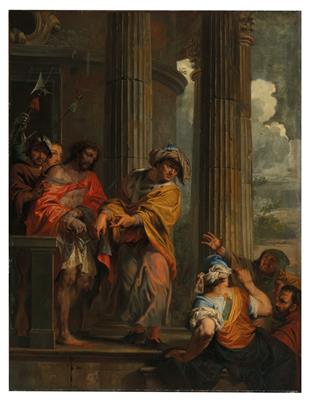Jan Erasmus Quellinus

(Antwerp 1634–1715 Mechelen)
Ecce Homo,
indistinctly signed and dated lower left: I. E. Quellinus pict. […] / Ao . 1681.,
oil on canvas, 151 x 116 cm, framed
Provenance:
Private European collection
A drawing by Jan Erasmus Quellinus with an almost identical composition, possibly a preparatory drawing for the present painting, is conserved in the Albertina Museum, Vienna.
The present work is heavily influenced both in style and composition by the works of Rubens, such as his Ecce Homo in the Hermitage Museum, with whom the artist’s father Erasmus Quellinus the Younger (1607–1678) had worked as an assistant. Jan Erasmus complimented his rich Rubensian heritage with a trip to Italy in 1660, during which he visited Venice, Naples, Florence and Rome, drawing particularly on the Venetian tradition embodied by painters such as Veronese. Jan Erasmus may find his sources in the Ecce Homo by Titian, Kunsthistorisches Museum, Vienna (inv. no. 73) and in the Ecce Homo by Tintoretto, São Paulo Museum of Art, Brasil.
Unlike his father, Jan Erasmus also included in his paintings grand architectural elements which were inspired by the Palladian architecture he saw in Italy, such as the large columns surrounding the entrance to the cylindrical building from which Christ and the soldiers exit.
The present painting is comparable with other Jan Erasmus’ paintings, such as Thetis Dips Achilles in a Vase with Water from the Styx, in a private collection, and the Crowning of Charles V in Bologna in the Kunsthistorisches Museum, Vienna (inv. no. 1766). In these compositions, the figures move along a diagonal, going from the top to the bottom of the canvas.
Jan Erasmus Quellinus was a member of the famous Quellinus family of artists which includes his father Erasmus Quellinus and the sculptor Artus Quellinus. He travelled to Rome in 1657–59, where he became a member of the Bentvueghels, a group of Dutch and Flemish artists. It was common practice for every member to receive a ‘bent name’ and he became known by the nickname Seederboom (cedar tree). After a sojourn in Venice, he returned to Antwerp in 1660 where he joined the Guild of Saint Luke and married the daughter of the painter David Teniers the Younger. It was in this period that he established himself as a successful artist and by 1680 he was working in Vienna for the Habsburg court as a court painter to Emperor Leopold I.
Esperto: Mark MacDonnell
 Mark MacDonnell
Mark MacDonnell
+43 1 515 60 403
oldmasters@dorotheum.com
11.05.2022 - 16:00
- Prezzo realizzato: **
-
EUR 51.200,-
- Stima:
-
EUR 15.000,- a EUR 20.000,-
Jan Erasmus Quellinus
(Antwerp 1634–1715 Mechelen)
Ecce Homo,
indistinctly signed and dated lower left: I. E. Quellinus pict. […] / Ao . 1681.,
oil on canvas, 151 x 116 cm, framed
Provenance:
Private European collection
A drawing by Jan Erasmus Quellinus with an almost identical composition, possibly a preparatory drawing for the present painting, is conserved in the Albertina Museum, Vienna.
The present work is heavily influenced both in style and composition by the works of Rubens, such as his Ecce Homo in the Hermitage Museum, with whom the artist’s father Erasmus Quellinus the Younger (1607–1678) had worked as an assistant. Jan Erasmus complimented his rich Rubensian heritage with a trip to Italy in 1660, during which he visited Venice, Naples, Florence and Rome, drawing particularly on the Venetian tradition embodied by painters such as Veronese. Jan Erasmus may find his sources in the Ecce Homo by Titian, Kunsthistorisches Museum, Vienna (inv. no. 73) and in the Ecce Homo by Tintoretto, São Paulo Museum of Art, Brasil.
Unlike his father, Jan Erasmus also included in his paintings grand architectural elements which were inspired by the Palladian architecture he saw in Italy, such as the large columns surrounding the entrance to the cylindrical building from which Christ and the soldiers exit.
The present painting is comparable with other Jan Erasmus’ paintings, such as Thetis Dips Achilles in a Vase with Water from the Styx, in a private collection, and the Crowning of Charles V in Bologna in the Kunsthistorisches Museum, Vienna (inv. no. 1766). In these compositions, the figures move along a diagonal, going from the top to the bottom of the canvas.
Jan Erasmus Quellinus was a member of the famous Quellinus family of artists which includes his father Erasmus Quellinus and the sculptor Artus Quellinus. He travelled to Rome in 1657–59, where he became a member of the Bentvueghels, a group of Dutch and Flemish artists. It was common practice for every member to receive a ‘bent name’ and he became known by the nickname Seederboom (cedar tree). After a sojourn in Venice, he returned to Antwerp in 1660 where he joined the Guild of Saint Luke and married the daughter of the painter David Teniers the Younger. It was in this period that he established himself as a successful artist and by 1680 he was working in Vienna for the Habsburg court as a court painter to Emperor Leopold I.
Esperto: Mark MacDonnell
 Mark MacDonnell
Mark MacDonnell
+43 1 515 60 403
oldmasters@dorotheum.com
|
Hotline dell'acquirente
lun-ven: 10.00 - 17.00
old.masters@dorotheum.at +43 1 515 60 403 |
| Asta: | Dipinti antichi I |
| Tipo d'asta: | Asta in sala con Live Bidding |
| Data: | 11.05.2022 - 16:00 |
| Luogo dell'asta: | Wien | Palais Dorotheum |
| Esposizione: | 30.04. - 11.05.2022 |
** Prezzo d’acquisto comprensivo dei diritti d’asta acquirente e IVA
Non è più possibile effettuare un ordine di acquisto su Internet. L'asta è in preparazione o è già stata eseguita.
